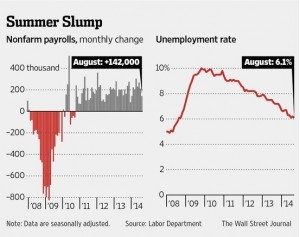Only 142,000 jobs were created in the United States in the month of August when economists predicted over 200,000…now everybody PANIC!!!
I’m Just kidding, don’t panic; but by the weight of media coverage that these monthly jobs numbers are given month after month, you’d be forgiven if you thought you should make immediate and drastic investment moves when you first hear the super-secret jobs number report from the labor department come out the first Friday of each month at 8:30AM Eastern Time. The truth is, the numbers are wildly inaccurate.
Don’t get me wrong, the number is important when looking at long term trends in the economy, and it can give us a better understanding of the labor market’s health. In fact there are numbers inside this report that tell statisticians and business planners a lot.
However, the numbers reported are based upon statistical estimates that can be wildly afar from the actual numbers. If you hear of I00,000 jobs created you can be reasonably sure that there were actually between 0 and 200,000 created. Similarly, if they show 500k created, the range would be from 600k-700k created, and so on.
This Jobs created or lost numbers is based upon a survey of hundreds of thousands of US businesses for the month and they statistically inflate that to mirror the overall economy. On top of the possible statistical error that may come about, they often adjust these numbers for ‘seasonal’ anomalies, such as in cyclical industries that have more hiring or layoffs due to

the season. Often the count of new jobs is also adjusted heavily in following months. Today, we saw the month of June’s jobs adjusted downward by over 30,000 jobs; that’s more than ten percent off the original report!
The unemployment rate, which for now stands at 6.1%, is based upon a survey of 60,000 households in a country of over 300,000,000. The census department interviews each household and asks them a series of questions about their work status over the previous month, and then they multiply this survey to reflect the population at large. This can make the actual percentage very dubious in its accuracy. In fact just before the 2012 election, we now know that when a survey taker in the Philadelphia area couldn’t get in contact with many of the households he was to survey (they are required to get 90% filled), he simply made the numbers up thus artificially lowering the jobless rate. The rate that is generally reported also does not indicate those who are underemployed or have been so frustrated they stopped looking and don’t get counted in that headline number.
What to make of this? There is no question that the last five years since the recession ended we have seen an anemic recovery that many believe should have been more robust. As I wrote earlier, the labor department’s report is useful for seeing trends in the economy, and those trends are backward looking as well. You’ll notice here in September, we got August jobs, not October’s.
And that’s exactly what the post-recession trend has shown and is still showing. Still anemic, still steady; but don’t make any rash moves based upon any one of these monthly reports.